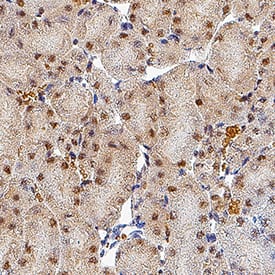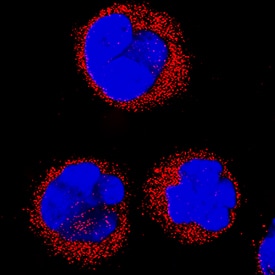Human/Mouse CRY1 Antibody
R&D Systems, part of Bio-Techne | Catalog # AF3764

Key Product Details
Species Reactivity
Validated:
Human, Mouse
Cited:
Mouse
Applications
Validated:
Immunocytochemistry, Immunohistochemistry, Western Blot
Cited:
Western Blot
Label
Unconjugated
Antibody Source
Polyclonal Goat IgG
Product Specifications
Immunogen
E. coli-derived recombinant human CRY1
Lys115-His224
Accession # Q16526
Lys115-His224
Accession # Q16526
Specificity
Detects human and mouse CRY1 in direct ELISAs.
Clonality
Polyclonal
Host
Goat
Isotype
IgG
Scientific Data Images for Human/Mouse CRY1 Antibody
CRY1 in MOLT‑4 Human Cell Line.
CRY1 was detected in immersion fixed MOLT-4 human acute lymphoblastic leukemia cell line using Goat Anti-Human/Mouse CRY1 Antigen Affinity-purified Polyclonal Antibody (Catalog # AF3764) at 5 µg/mL for 3 hours at room temperature. Cells were stained using the NorthernLights™ 557-conjugated Anti-Goat IgG Secondary Antibody (red; Catalog # NL001) and counterstained with DAPI (blue). Specific staining was localized to nuclei and cytoplasm. View our protocol for Fluorescent ICC Staining of Non-adherent Cells.Detection of CRY1 in Human Testis.
CRY1 was detected in immersion fixed paraffin-embedded sections of human testis using Goat Anti-Human/Mouse CRY1 Antigen Affinity-purified Polyclonal Antibody (Catalog # AF3764) at 0.5 µg/ml for 1 hour at room temperature followed by incubation with the Anti-Goat IgG VisUCyte™ HRP Polymer Antibody (Catalog # VC004). Before incubation with the primary antibody, tissue was subjected to heat-induced epitope retrieval using VisUCyte Antigen Retrieval Reagent-Basic (Catalog # VCTS021). Tissue was stained using DAB (brown) and counterstained with hematoxylin (blue). Specific staining was localized to the nucleus and cytoplasm. View our protocol for IHC Staining with VisUCyte HRP Polymer Detection Reagents.Detection of CRY1 in Mouse Kidney.
CRY1 was detected in immersion fixed paraffin-embedded sections of mouse kidney using Goat Anti-Human/Mouse CRY1 Antigen Affinity-purified Polyclonal Antibody (Catalog # AF3764) at 0.5 µg/ml for 1 hour at room temperature followed by incubation with the Anti-Goat IgG VisUCyte™ HRP Polymer Antibody (Catalog # VC004). Before incubation with the primary antibody, tissue was subjected to heat-induced epitope retrieval using VisUCyte Antigen Retrieval Reagent-Basic (Catalog # VCTS021). Tissue was stained using DAB (brown) and counterstained with hematoxylin (blue). Specific staining was localized to the nucleus and cytoplasm. View our protocol for IHC Staining with VisUCyte HRP Polymer Detection Reagents.Applications for Human/Mouse CRY1 Antibody
Application
Recommended Usage
Immunocytochemistry
5-15 µg/mL
Sample: Immersion fixed MOLT‑4 human acute lymphoblastic leukemia cell line
Sample: Immersion fixed MOLT‑4 human acute lymphoblastic leukemia cell line
Immunohistochemistry
0.5-15 µg/mL
Sample: Immersion fixed paraffin-embedded sections of human testis and mouse kidney.
Sample: Immersion fixed paraffin-embedded sections of human testis and mouse kidney.
Western Blot
0.1 µg/mL
Sample: Recombinant Human CRY1
Sample: Recombinant Human CRY1
Formulation, Preparation, and Storage
Purification
Antigen Affinity-purified
Reconstitution
Reconstitute at 0.2 mg/mL in sterile PBS. For liquid material, refer to CoA for concentration.
Formulation
Lyophilized from a 0.2 μm filtered solution in PBS with Trehalose. See Certificate of Analysis for details.
*Small pack size (-SP) is supplied either lyophilized or as a 0.2 µm filtered solution in PBS.
*Small pack size (-SP) is supplied either lyophilized or as a 0.2 µm filtered solution in PBS.
Shipping
Lyophilized product is shipped at ambient temperature. Liquid small pack size (-SP) is shipped with polar packs. Upon receipt, store immediately at the temperature recommended below.
Stability & Storage
Use a manual defrost freezer and avoid repeated freeze-thaw cycles.
- 12 months from date of receipt, -20 to -70 °C as supplied.
- 1 month, 2 to 8 °C under sterile conditions after reconstitution.
- 6 months, -20 to -70 °C under sterile conditions after reconstitution.
Background: CRY1
Long Name
Cryptochrome 1
Alternate Names
Cryptochrome I, PHLL1
Gene Symbol
CRY1
UniProt
Additional CRY1 Products
Product Documents for Human/Mouse CRY1 Antibody
Product Specific Notices for Human/Mouse CRY1 Antibody
For research use only
